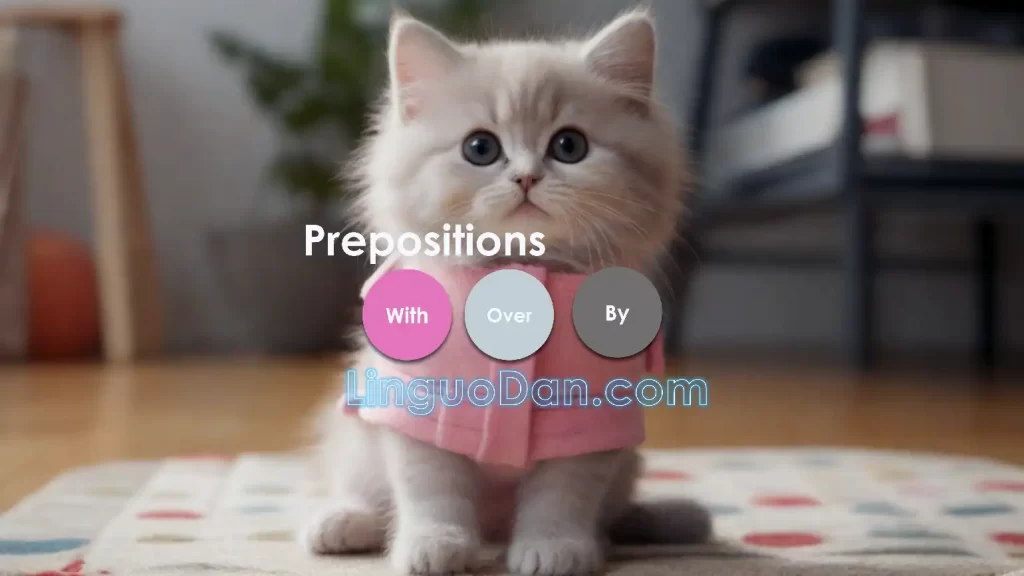Prepositions: “With,” “Over,” and “By” in English

Learning prepositions: “With”, “Over” and “By” in English
Prepositions play a crucial role in the English language, helping to convey relationships between words in a sentence. Three commonly used prepositions, “with,” “over,” and “by,” have distinct meanings and usage. Understanding when and how to use these prepositions can significantly enhance one’s proficiency in English. In this article, we will delve into the nuances of using “with,” “over,” and “by” in different contexts.
1. Preposition “With” in English
The preposition “with” is versatile, serving multiple purposes in English. It primarily denotes association, accompaniment, or possession. Here are some common use cases:
- Association: “I had lunch with my friends.” In this example, “with” indicates the companionship during the activity.
- Possession: “The book with the blue cover is mine.” Here, “with” establishes a connection between the book and its distinctive feature.
- Instrumentality: “I cut the bread with a knife.” In this context, “with” communicates the tool or means used to perform the action.
The use of the preposition “With” in English
The preposition “with” is used in the English language in several different ways:
-
To indicate being together or in the company of someone:
- Example: “I went to the movie with my friend.”
-
To suggest the cause of a feeling or a state of being:
- Example: “She was shivering with cold.”
-
To imply using an instrument or tool:
- Example: “He cut the vegetables with a knife.”
-
To signify a characteristic or attribute:
- Example: “A lady with blue eyes won the contest.”
-
To represent a manner or way:
- Example: “She spoke with passion.”
-
To show an action performed together or in agreement with someone:
- Example: “She agreed with her colleagues to postpone the meeting.”
2. Preposition “Over” in English
The preposition “over” implies a movement across a surface or a change in position. It also denotes a spatial relationship between objects. Consider the following examples:
- Spatial relationship: “The plane flew over the mountains.” Here, “over” indicates the position of the plane in relation to the mountains.
- Change of position: “She knocked the cup over.” In this case, “over” signifies the change in the cup’s position from an upright to a fallen state.
- Duration: “I’ll be working on this project over the weekend.” The preposition indicates a span or duration of time.
The use of the preposition “over” in English
The preposition “over” can be used in several different contexts in the English language:
-
To indicate physical location or movement from one place to another, especially when one thing is directly above another or covering it:
- Example: “The plane flew over the city.”
-
To indicate more than a particular amount, extent, or degree:
- Example: “He’s over six feet tall.”
-
To denote a period of time:
- Example: “Over the years, we have made many improvements to our house.”
-
To signify control, authority, or responsibility:
- Example: “As a manager, she has control over the project.”
-
To describe remaining or surviving:
- Example: “Despite the situation, many businesses still managed to triumph over adversity.”
-
In expressions of communication and broadcasting:
- Example: “I heard the news over the radio.”
These examples show some of the most common uses of “over,” but like any preposition, there are exceptions and idiomatic uses that might not necessarily follow these standard rules.
3. Preposition “By” in English
The preposition “by” is versatile, serving various functions related to proximity, means, and agency. Let’s explore its applications:
- Proximity: “The café is by the park.” In this instance, “by” denotes the closeness of the café to the park.
- Means: “She painted the picture by using watercolors.” Here, “by” indicates the means or method employed in creating the artwork.
- Responsibility: “The novel was written by a famous author.” In this case, “by” introduces the person or entity responsible for the action.
The use of the preposition “By” in English
The preposition “by” has multiple functions in the English language, and here are some common ways it is used:
-
To indicate means of transportation:
- Example: “We traveled by car to the beach.”
-
To show proximity:
- Example: “She sat by the window to enjoy the view.”
-
To denote the method or manner of doing something:
- Example: “He completed the project by working hard.”
-
To express the doer of an action:
- Example: “The book was written by the author.”
-
To indicate proximity to a place or thing:
- Example: “The tree is by the river.”
-
In expressions of time:
- Example: “I will meet you by Monday.”
-
To show a boundary or limit:
- Example: “The park is by the lake.”
Remember, these are general rules, and there may be exceptions or idiomatic uses in the language that don’t necessarily follow these standard uses.
In conclusion, prepositions “with,” “over,” and “by” are integral to the English language and understanding their nuanced usage is fundamental for clear and effective communication. By familiarizing oneself with their meanings and exploring various contextual examples, learners can navigate these prepositions with confidence and accuracy in their English communication.